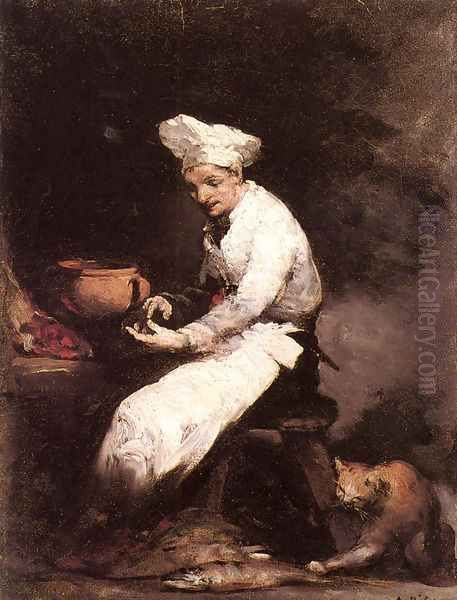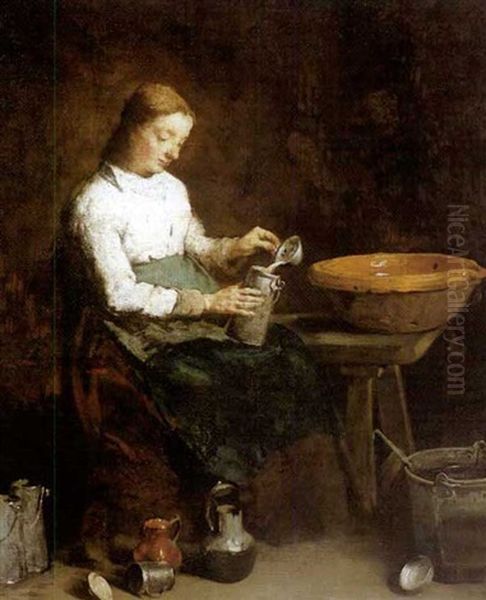Théodule Augustin Ribot stands as a significant figure in nineteenth-century French art, a painter and printmaker deeply rooted in the Realist movement. Born on August 8, 1823, in Saint-Nicolas-d'Attez, Eure, and passing away on September 11, 1891, in Colombes, Hauts-de-Seine, Ribot carved a distinct path through the bustling Parisian art scene. His work is celebrated for its profound psychological depth, its often somber but powerful portrayal of everyday life, and its masterful use of chiaroscuro, echoing the dramatic intensity of Spanish and Dutch Old Masters.
Though associated with Realism, Ribot's art possesses a unique character, blending meticulous observation with a palpable sense of empathy for his subjects. He navigated a challenging life, marked by early hardship and persistent financial concerns, yet remained dedicated to his artistic vision, eventually gaining recognition and leaving behind a compelling body of work that continues to resonate.
Early Life and Artistic Awakening
Théodule Ribot's journey into art began amidst adversity. Born into a family of modest means, his innate artistic talent was evident from a young age. However, the premature death of his father thrust heavy responsibilities upon him. Forced to prioritize his family's survival, the young Ribot undertook various menial jobs, delaying his formal artistic pursuits. This early exposure to hardship likely shaped his later artistic focus on the lives of ordinary people and the dignity found in labor and simple domesticity.
In 1845, seeking to finally pursue his calling, Ribot made the pivotal move to Paris. The city, the undisputed center of the European art world, offered opportunities for training and exposure. He enrolled in the studio of Auguste-Barthélemy Glaize, a painter known for his historical and allegorical works. While this formal training provided foundational skills, much of Ribot's development appears to have been self-directed, driven by diligent study and observation, particularly of the masterworks housed in the Louvre.

His initial years in Paris were far from glamorous. To support himself and his family, Ribot engaged in various forms of commercial art, including the painstaking work of decorating and gilding picture frames for other artists and craftsmen. This practical experience, though born of necessity, may have honed his eye for detail and composition, skills that would later define his paintings.
Forging a Path in Realism
Ribot's transition from artisan work to fine art painting occurred gradually. By the late 1840s and early 1850s, he began dedicating more time to his own canvases. His artistic direction aligned strongly with the burgeoning Realist movement, spearheaded by figures like Gustave Courbet. Realism sought to depict the world truthfully, rejecting the idealized subjects of Neoclassicism and the dramatic narratives of Romanticism in favor of contemporary life, often focusing on the working classes and mundane scenes.
Ribot embraced this ethos, finding compelling subjects in the humble corners of Parisian life. His early works often featured cooks, scullions, and domestic servants engaged in their daily tasks. Kitchen interiors, simple still lifes composed of everyday objects like eggs, bread, and copper pots, became recurring motifs. These were not merely exercises in technical skill but imbued with a quiet dignity and a profound sense of presence.
His approach was distinct from some of his contemporaries. While Courbet often tackled large-scale social statements, Ribot's Realism was typically more intimate and introspective. He shared an affinity with artists like François Bonvin, who also specialized in genre scenes and still lifes characterized by their sincerity and careful execution. Bonvin, in fact, became an important friend and supporter, helping Ribot navigate the competitive Parisian art world.
The Power of Chiaroscuro
Perhaps the most defining characteristic of Théodule Ribot's style is his dramatic use of chiaroscuro – the strong contrast between light and dark. This technique, drawing heavily on the influence of seventeenth-century masters, became his signature. He deeply admired the Spanish painters Jusepe de Ribera and Diego Velázquez, as well as the Dutch master Rembrandt van Rijn, whose works exemplified the expressive potential of light and shadow.
Ribot employed chiaroscuro not just for visual drama, but primarily to enhance the psychological intensity of his scenes and subjects. Figures often emerge from deep, velvety darkness, illuminated by a focused, sometimes stark, light source. This isolates the subject, drawing the viewer's attention to subtle expressions, gestures, or the textures of objects. The surrounding darkness creates an atmosphere of intimacy, contemplation, or sometimes, profound melancholy.

His palette was often restricted, dominated by rich blacks, deep browns, ochres, and creams, punctuated by flashes of brighter color in specific details. While some critics occasionally found his coloration too somber or lacking the vibrancy favored by emerging movements like Impressionism, others recognized his mastery in manipulating tone to create mood and volume. His handling of paint was often robust and textured, further enhancing the tactile quality and emotional weight of his compositions.
Salon Success and Recognition
The Paris Salon, the official art exhibition of the Académie des Beaux-Arts, was the primary venue for artists seeking recognition and patronage in the 19th century. Ribot faced initial difficulties, with some of his works being rejected by the conservative Salon jury. However, his persistence paid off. In 1861, he successfully exhibited a group of kitchen scenes, which garnered positive attention and marked his official entry into the public art sphere.
His reputation grew steadily. The Salons of 1864 and 1865 proved particularly successful, earning him medals and critical acclaim. It was during this period that he produced one of his most celebrated works, Saint Sebastian, Martyr (1865). This powerful religious painting, depicting the saint pierced by arrows and bathed in dramatic light against a dark background, showcased Ribot's mastery of anatomy, composition, and chiaroscuro to convey suffering and spiritual endurance. The work was widely praised and purchased by the state for the Musée du Luxembourg, cementing his status as a significant contemporary artist.
Throughout the 1860s and 1870s, Ribot continued to exhibit regularly, presenting genre scenes, portraits, still lifes, and increasingly, religious subjects. Works like The Admonition and Girl with Eggs exemplify his ability to capture poignant moments of everyday life with sensitivity and technical brilliance. He became associated with a group of independent-minded artists, including Henri Fantin-Latour, James McNeill Whistler, and Alphonse Legros, who sometimes exhibited together outside the official Salon system, seeking greater artistic freedom.
Contemporaries and Artistic Milieu
Ribot operated within a rich and dynamic artistic environment. His commitment to Realism placed him alongside Gustave Courbet, though Ribot's approach was generally less overtly political. He shared thematic interests with Jean-François Millet, who famously depicted peasant life, and Honoré Daumier, known for his sharp social commentary in painting and printmaking. His friendship with François Bonvin was particularly important, representing a shared dedication to intimate genre scenes and still life.
While distinct from the Impressionists who were beginning to challenge artistic conventions in the 1860s and 1870s, Ribot's path occasionally intersected with theirs. Figures like Édouard Manet, whose own work often courted controversy, were part of the same Parisian milieu. Although Ribot's technique remained rooted in tonal painting rather than the Impressionists' exploration of broken color and fleeting light effects, his focus on contemporary subjects and his independence from strict academicism placed him within the broader shift towards modern art.
His connections extended to artists like Alphonse Legros, who moved to London, and the American expatriate James McNeill Whistler, indicating his participation in a network that transcended purely French circles. He was also involved in organizational efforts, contributing to the establishment of alternative exhibition venues like the Salon du Champ de Mars, reflecting a desire among many artists for greater autonomy from the official Salon.
Challenges and Later Years
Despite achieving considerable recognition, Ribot's life was not without significant challenges. Financial worries seem to have been a persistent undercurrent, a legacy perhaps of his difficult youth. A major blow occurred during the Franco-Prussian War (1870-1871) and the subsequent Paris Commune. His home and studio in Colombes, located outside Paris, were damaged or destroyed during the conflict, resulting in the loss of numerous paintings and personal belongings. This event was a profound setback, both emotionally and professionally.
Following the war, Ribot rebuilt his life and career. He continued to paint, perhaps with an even greater focus on religious themes in the 1870s, possibly reflecting a deeper contemplation spurred by the recent turmoil. His Saint Sebastian remained a touchstone, but he produced other significant religious works, often imbued with the same dramatic intensity and psychological focus.
His family life also saw its share of difficulties. His son, Germain Ribot, followed in his father's footsteps and became a painter, exhibiting alongside him. However, Germain suffered from poor health and was forced to abandon his artistic career around 1883, which must have been a source of sorrow for Théodule. Despite these personal and professional trials, Ribot remained productive until his final years, passing away in Colombes in 1891 at the age of 68.
Legacy and Reappraisal
During his lifetime, Théodule Ribot earned respect as a skilled and sincere painter. He was admired for his technical prowess, particularly his command of light and shadow, and for the emotional honesty of his work. He received official recognition, including the Legion of Honour in 1878. However, his commitment to a darker palette and traditional techniques meant he was sometimes overshadowed by the more radical innovations of the Impressionists and Post-Impressionists in the eyes of progressive critics.
His reputation saw a period of relative neglect in the early 20th century, as art history focused heavily on the avant-garde movements. However, subsequent reappraisals have reaffirmed his importance within the Realist tradition and as a master of chiaroscuro. His influence can be seen in later artists who valued strong tonal contrasts and psychological depth.
Today, Ribot is recognized for his unique contribution to 19th-century French art. His paintings offer a compelling counterpoint to Impressionism, demonstrating that powerful modern art could also be created through a dialogue with the Old Masters. His depictions of humble subjects, rendered with profound empathy and dramatic intensity, continue to engage viewers. His works are held in major museums worldwide, including the Musée d'Orsay in Paris, the Metropolitan Museum of Art in New York, and the National Gallery in London, securing his place as an enduring figure in the history of art. His ability to find beauty and significance in the ordinary, illuminated by his signature play of light and shadow, remains his lasting legacy.